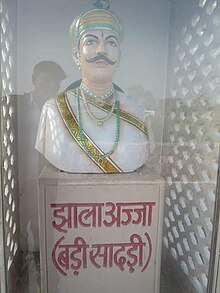Jhala Ajja
An editor has nominated this article for deletion. You are welcome to participate in the deletion discussion, which will decide whether or not to retain it. |
| Jhala Ajja | |||||
|---|---|---|---|---|---|
| Jhalleswar Maharaj-Maharana Raj Rana | |||||
 Statue of Jhala Ajja, Bari Sadri | |||||
| Maharaj-Maharana of Jhalawad | |||||
| Reign | 1499-1500 | ||||
| Predecessor | Rajodharji Jhala | ||||
| Successor | Ranoji Jhala | ||||
| Raj Rana of Ajmer, Gogunda and Bari Sadri | |||||
| Reign | 1506-1527 | ||||
| Predecessor | Post established | ||||
| Successor | Rajrana Siha Jhala | ||||
| Born | 1479 Kathiawar | ||||
| Died | 17 March 1527 Khanwa, Rajasthan | ||||
| Spouse | Rani Roop deviji, daughter of Rana Raimal of Mewar | ||||
| Issue | Siha | ||||
| |||||
| House | |||||
| Dynasty | Jhala dynasty | ||||
| Military career | |||||
| Allegiance | Kingdom of Mewar | ||||
| Battles / wars |
| ||||
| Father | Maharana Rajodhar Jhala | ||||
| Mother | Rani Surajkunwar Rathore of Idar | ||||
| Religion | Hinduism | ||||
Ajay Singh Jhala, commonly known as Jhala Ajja and Ajoji, was the deposed ruler of Jhalawad who served as Governor of Ajmer with the title of Rana under the Maharana of Mewar. He pretended to be Rana Sanga during the Battle of Khanwa. He was also the maternal uncle of Rana Sanga as well as Rana Sanga's step sister's husband.[1]
Early life
[edit]Ajay Singh was born to Rajodharji, the Maharana of Jhalawad and his Rathore wife Surajkunwar of Idar in the year 1479 in Kathiawar. He was coronated as the Maharana of Jhalawad in 1499 AD. Later in 1500 AD, When his father died, he, along with his brother Sajoji, went outside the city to perform the funeral rites. While they were away, Lakhadhirji of Muli, whose daughter was the mother of Ranoji, the third son of Rajodharji, closed the city gates, distributed gifts to the soldiers, and proclaimed Ranoji as the Raj of Halvad. Ajja, along with his brother Sajoji, tried to re-enter the city but failed. They then retired to the village of Vegadwao, where they stayed for two months. Afterward, they went to Ahmedabad to seek justice from Mahmud Begada, but they were unsuccessful because Lakhadhirji had already given him a nazrana of two lakhs of rupees and secured recognition for Ranoji.[2] After realizing their attempts to remove Ranoji had failed, they went to Idar and then to Jodhpur, where they received a cold welcome.
Service in Mewar
[edit]
From there, they traveled to the court of Rana Raimal, who was his sister's husband and entered his service in 1506. Raimal gave Ajoji the Jagirs of Ajmer, Gogunda and Jhadol, and Sajoji the Jagir of Delwara.[2] He participated in all the battles fought by Rana Sanga, like the battle of Khanwa that was fought between Rana Sanga and Babur. When Rana Sanga was wounded during the battle and taken off the field to Ranthambhore, the question arose of who would impersonate him on the battlefield. Rawat Ratan Singh of Salumbar was asked to impersonate him by assuming the insignia of royalty, but he declined because his ancestor, Chunda, had yielded his right to Mewar in favor of his younger brother, Mokal.[3][need quotation to verify] Later, after much discussion, it was decided that Ajja would impersonate Rana Sanga.[1] Ajja then took Rana Sanga's place on his elephant and thus bore the brunt of the battle.[4] A chattra was held over him, and the chanwar was waved above his head.[3][need quotation to verify] For a while, the Rajputs continued fighting, but the rumor soon spread that Rana Sanga had been wounded and removed from the field.[3][need quotation to verify] Various parts of Rana Sanga’s army, not finding their leader present, left the field, resulting in Ajja being slain in battle. His son Siha (or Singha) was granted by Ratan Singh II the fief of Bari Sadri, the title of Raj, the seat of honor next to the Maharana, and the right to carry the royal insignia of Mewar.[4] He was also allowed to beat his kettle drums up to the gate of the palace.
In popular culture
[edit]- 1988–1989: Bharat Ek Khoj, broadcast on Doordarshan, where he was played by Devendra Malhotra.
References
[edit]- ^ a b Somani, Ram Vallabh (1976). History of Mewar: from earliest times to 1751 A.D. C.L. Ranka, Jaipur. p. 174.
- ^ a b Shastri, Dr Miss R. P. (1961). Jhala Zalim Singh (1730-1823). p. 20.
- ^ a b c Sharma, G. n (1954). Mewar And The Mughal Emperors. pp. 38–39.
- ^ a b Rajvi Amar Singh (1965). Mediaeval History Of Rajasthan (vol- 1). p. 37.
